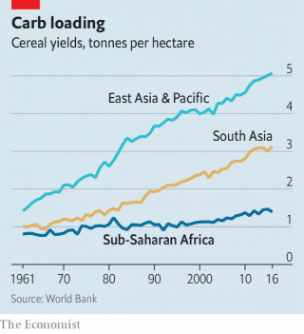This is from a new paper by Alicia Barriga and Nathan Fiala in World Development:
Results from the tests showed very high levels of DNA similarity (above 98%) and good performance in general, but highly variable quality in terms of the ability of the seed to germinate under standard conditions. We do not see differences in average outcomes across the distribution levels, though variation in seed performance does increase further down the supply chain.
The results of the tests point to potentially important issues for the quality of seeds. The variation in germination suggests that buying a random bag of seeds in this particular distribution chain can matter a lot for farmer’s production. The high rate of seed similarity suggests that the main concern among policy makers and researchers, that sellers add inert or low-quality material to the seeds, is likely not the case, at least for the maize sector in the districts we study. However, given the remoteness of these districts and the lack of any oversight in these areas, we believe the results are likely a lower bound for the country as a whole.
The supply chain analysis suggests that the quality of seed does not deteriorate along the supply chain. The quality is the same, on average, across all types of suppliers after leaving the breeders. However, we observe high variation of seeds’ performance results on germination, moisture, and vigor, suggesting that results are more consistent with issues of mishandling and poor storage of seeds, possibly related to temperature or quality controls, rather than sellers purposefully adulterating seeds. Variation on these indicators is usually associated with mishandling during transportation and storage.
As the authors note in the paper, African governments and their external donors have put a lot of effort in “certification and labeling so as to reduce the possibility of adulteration by downstream sellers”. Obviously, e-labels and systems of verifying seed authenticity in the fight against adulteration are important. But equally important is an understanding of how the seed distribution system works. And that is one of the major contributions of this paper. Corruption is not always the problem.

Interestingly, Uganda bests both Kenya and Tanzania on productivity in the cereal sector (I made the graph using FAO data). Despite starting off with relatively lower productivity and having gone through civil conflict beginning in the late 1970s, Uganda has since around 2007 clearly separated itself from both Kenya and Tanzania (and appears to have plateaued). Productivity in Kenya peaked in the early 1980s and has pretty much stagnated since. Tanzania’s figures appear to be trending upwards having collapsed in the early 2000s. There is likely an element of soil quality and general aridity involved in these trends. According to the FAO, Kenya and Tanzania use fertilizer at significantly higher rates than Uganda. For comparison, cereal yield in Vietnam is about 2.7 times higher than in Uganda.
 Something akin to Asia’s rural development may, at last, be happening in parts of Africa. Since 2002 the proportion of African workers employed in agriculture has fallen from 66% to 57%. Yet the real value of agricultural production has grown at an average pace of 4.6% a year, double the rate between 1970 and 2000. Even so, the region is lagging behind. Most of the increase comes from using more land, rather than improved productivity.
Something akin to Asia’s rural development may, at last, be happening in parts of Africa. Since 2002 the proportion of African workers employed in agriculture has fallen from 66% to 57%. Yet the real value of agricultural production has grown at an average pace of 4.6% a year, double the rate between 1970 and 2000. Even so, the region is lagging behind. Most of the increase comes from using more land, rather than improved productivity.